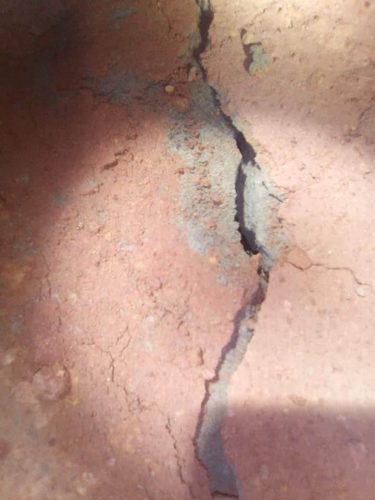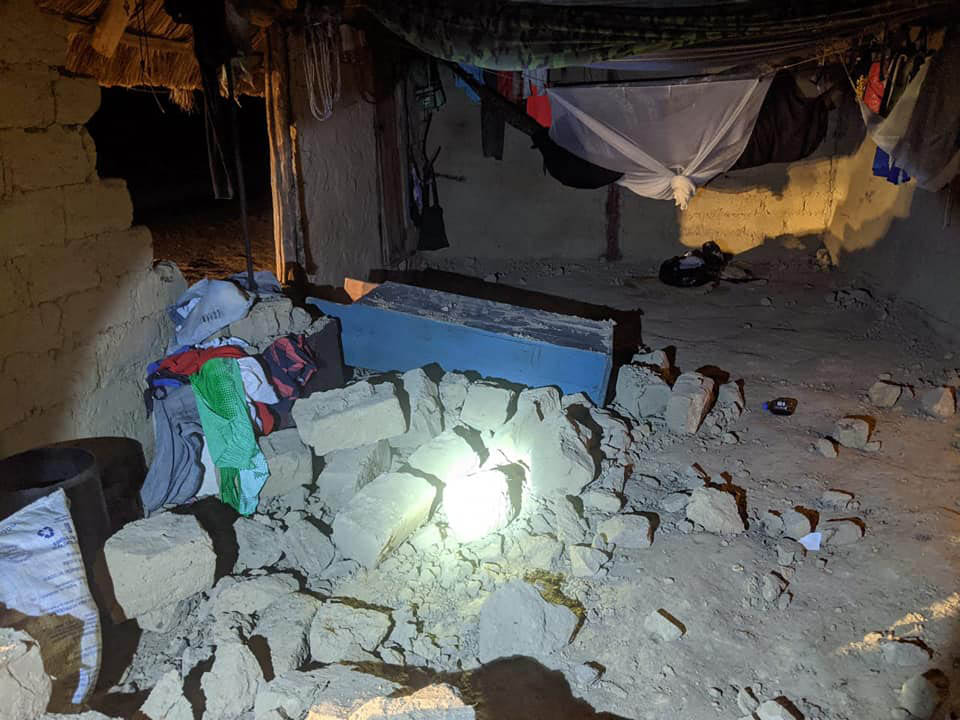Twenty-four hours after a 5.7 magnitude earthquake rocked the Deep South Rupununi, communities close to the epicentre are still experiencing aftershocks according to reports from the region.
As a result of Sunday afternoon’s earthquake two homes in the community of Katoonarib were destroyed, displacing at least seven persons.
Kid James of the South Rupununi District Council yesterday told Stabroek News that the communities in close proximity to the epicentre continue to experience mild tremors.

He explained that just after the council received reports of the earthquake damage in Katoona-rib and Sawariwau a team departed along with the police from Aishalton to investigate.
According to James, while many of the homes suffered from cracked walls as a result of the heavy vibrations, only two homes in Katoonarib were destroyed. At the time, he noted that the occupants were not at home.
He said that the walls of the homes were completely torn apart and sections bore severe cracks.
“It is fortunate that the occupants were not at home. The bricks for one of the houses fell inwards so it could have hurt anyone home,” James related.
He explained too that the community reported that they keep hearing explosive noises in close proximity to the Rupununi River. Many villagers he said are still scared and are fearful of what a recurrence could do to the communities.
James said the Regional council was scheduled to visit the community during the course of yesterday and make an assessment of the damage.
In the interim, the family has been relocated and they have advised villagers to take precautions.
At approximately 3.05 pm on Sunday, the 5.7 magnitude of earthquake was felt in most of southern Guyana and neighbouring countries, Brazil and Venezuela.
The quake was likely the strongest to have been registered in Guyana in many years and was felt in Brazil and Venezuela and all the way to the coast in the capital city.
The United States Geological Survey (USGS) listed the earthquake as 5.7 on the Richter Scale and located the epicentre at 83 km south south east of Lethem.
The European Mediterranean Seismological Centre also listed the temblor at 5.7 and also registered eight aftershocks.
Ann Williams, a teacher and a resident of Sawariwau situated in the vicinity of the epicentre said the experience was “scary.”
Recalling on Sunday what happened, she said at around 3.08 pm they felt the heavy vibrations and quickly ran out of their homes as everything was shaking.
“I was on the bed with my son doing some school work and we felt the vibrations and started to panic so we ran out the house. We just felt this hard vibration and it went on for like 5 minutes. It was continuous and then it went away slowly… When we went out, all the houses were shaking and you could have hear thatch roofs vibrating. It is strange for us because we never experienced anything like this,” the woman related, before stating that the community had heard a loud rumbling since yesterday morning.
She explained that since December the community has been hearing strange noises and feeling vibrations.
“We never take it for nothing but now today we knew that it was an earthquake. It always sounds as if a bus or truck passing,” she related.
According to the woman, in her community the damage was minimal as some walls cracked and items in their homes broke.
The earthquake recorded a shallow depth of 9.7 km and lasted for several minutes and was felt in Regions, 4,6,7,9 and 10.
The Civil Defence Commis-sion, its head, Kester Craig said continues to monitor the effects of the earthquake through the National Emergency Monitoring System (NEMS) and will provide updates as more information becomes available.
Persons who suffered any damage from the impact can contact NEMS at (592) 600.7500 or at (592) 623.1700.





